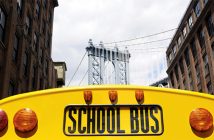
By Julia Steiny
A few years ago a kid we’ll call Leon transferred from a big urban district to the small, even poorer district where I consult on restorative practices. As a 7th grader, Leon was small for his age and scrappy. When not disrupting class or wandering the halls, his head was firmly on the desk. He did zero work. By December he was no longer a mere “frequent flier,” but the number one champ of discipline referrals.
Such kids drive dedicated urban teachers to cruise job postings in suburban towns and to demand “alternative placements” for unwanted kids. But no one learns community-appropriate behavior when segregated in a behavior-disorder classroom, a residential facility, or a prison. But what to do? The choice seems to be either wrecking that kid’s life by kicking him out or wrecking the learning environment of the other kids — never mind driving the teachers nuts.
But this middle school’s bold principal stepped into the fray. A committed, experienced Restorative Practioner (RP) herself, she had established a restorative-practices implementation team to work on climate-and-culture issues. While Response to Intervention (RTI) and special education teams address the needs of individual kids one at a time, an RP team supports the health of the school community as a whole.
Ideally, the team creates restorative solutions to prevent anticipated problems like tardiness or class-cutting. But sometimes the “frequent fliers” consume so much community attention that they need concentrated help as a group. So, the principal asked the RP team to assemble all possible information on each high-maintenance child.
The team member assigned to Leon knew his mother was hard to reach.
Mom works, and was royally sick of getting calls from the school. Still, the team needed to know what he was like at home. Might there be a relative, a neighbor, or family friend who could help Mom? Does the family have any social services already in place? If so, what? Did Leon’s teachers have any theories as to what might be up with him? And lo: one teacher suggested he might need glasses. Ultimately, that piece of intel was the key that unlocked the mystery.
But getting anything done beyond the school walls is way easier said than done. Some enterprising school nurses might have personal relationships with outside providers, but schools don’t have optometrists on call. They refer such matters to the parents, hoping they have insurance, willingness and capacity to pursue the issue. If not, though, good luck navigating the hurdles presented by public-service bureaucracies and insurance companies. It’s not really the school’s job. But in collaboration with a local private social-services organization, the RP team helped Mom sign up for a program that could arrange an eye test.
Sure enough, Leon couldn’t possibly see the board in class, never mind tease out the tiny letters in a book. But optometrists don’t just give out glasses, so the team had yet another hurdle to clear — which they somehow did.
And Leon’s discipline referrals full-on stopped.
This story is only unusual because of its extremes. Leon’s infuriating disruptiveness ended abruptly when he could finally use his eyesight. More typical are serious behavior problems with roots in trauma, neglect, and family dysfunction. The Herculean efforts of the RP team managed a stupidly-quick fix for Leon, but trauma cases are harder and far more tangled. But solutions will never be found, leaving the problems to fester, unless someone puts in the effort to unpack the problem and come up with answers.
All schools need an RP team seamlessly connected to outside agencies focused on mental health, housing, physical health, juvenile justice or whatever is needed. I suspect that in my state, Rhode Island, the bureaucracies are especially insulated from one another. But I don’t think it’s common that teachers work closely with non-school social workers. Kids’ lives are not divided by sectors. Some need diverse teams.
Leon’s issue was resolved with a bit of medical help and then a way to pay for glasses. That it was so hard to accomplish wasn’t the school’s fault. It’s just not their job. But enough troubled behavior can bring teaching and learning to a halt. RP teams might have to help the whole family become healthier before the child’s behavior improves. But schools tend to live in little worlds of their own. Confidentiality, funding, policies and fiefdoms prevent disparate agencies from working together to restore a kid’s life.
There are no bad kids, only bad behavior.
Before the RP team went on its forensic search, Leon was essentially being punished for poor eyesight. Similarly, traumatized kids are punished for not having a better response to their trauma. Troubled behavior will not respond to carrot-and-stick discipline tactics. Somehow, someone needs to stop the assembly line to give significant time and attention to some kids’ problems and more time working on solving them.
That requires time, labor, and resources. Redeploying existing outside services to help schools would be best. But organizing that would be a big lift — even though it would save tons of time, money and misery in the long run.
New Year’s Resolution: Take the Time to Restore Kids’ Lives
0
Share.




